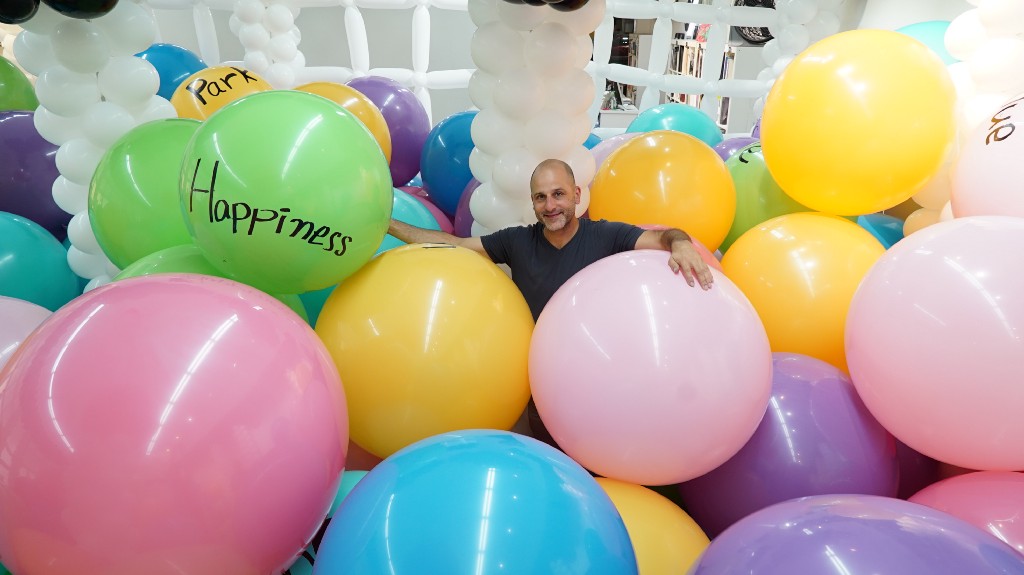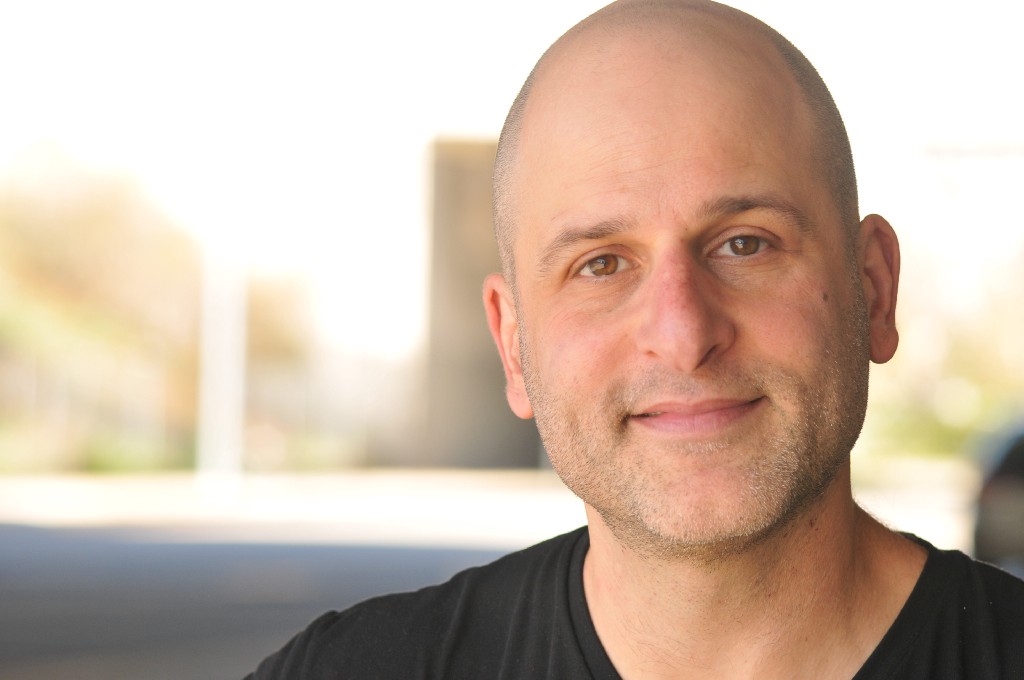The most fundamental example of leadership can be seen with parents and their kids. Finger-wagging morality, unfortunately, seems to be the norm, though kids quickly see through it, and by their parents being phony it actually teaches them how to be phony. Modeling behavior is the healthiest way to teach kids, so in that sense, real leadership begins (and ends) with authenticity.
As part of my series about “authors who are making an important social impact”, I had the pleasure of interviewing Addi Somekh.
Addi Somekh is recognized as one of the most innovative, prolific and well-traveled balloon artists in the world today. He has appeared on The Today Show, The Tonight Show, and Martha Stewart, as well as working for companies such as Google, Nike and Oprah. He also starred in his own TLC reality show “The Unpoppables,” which followed his company, New Balloon Art, building impossibly large, interactive balloon installations at high-end events across the globe. In his career, he traveled to 35 countries in an exploration on the origins of laughter and joy, using his balloon art to bring people of different cultures and backgrounds together. That journey is captured in stunning photographs and travel tales in his latest book Inflatable Planet (Goff Books) coming out Fall/Winter 2022.
Thank you so much for joining us in this interview series! Before we dive into the main focus of our interview, our readers would love to “get to know you” a bit better. Can you tell us a bit about your childhood backstory?
I was raised in a super secular and cerebral household. Both my parents considered religion to be like the Tooth Fairy for adults — a happy story to soothe a scary life. When I was 11, I asked my mom, “What happens when we die?”, and her immediate and honest response was “We stay dead.” Best answer I have ever been given, for any question, as it saved me untold years of anxiety from ruminating about the unknowable. But once I was in my early 20’s, when I started getting serious about balloon twisting and felt my first waves of inspiration, I realized that my best ideas did not actually originate with me, so that opened my horizons to the “spirit” in “inspiration”.
When you were younger, was there a book that you read that inspired you to take action or changed your life? Can you share a story about that?
When I was five or six, just old enough to start thinking and feeling at the same time, I read “The Giving Tree’’ by Shel Silverstein, and that gave me my first experience of devastating heartache (the impact/imprint was so big that it still gives me the shivers and I’m still too scared to reread it). On the flip side, when I was 13 I checked out the cassette of Tom Waits’ “Rain Dogs” album from the local public library, and from the first note, I knew I found my people. The characters in his songs were vivid yet so mysterious, and it taught me the beautiful power of a unique personality.
It has been said that our mistakes can be our greatest teachers. Can you share a story about the funniest mistake you made when you were first starting? Can you tell us what lesson you learned from that?
I was at my friend’s house and we were sober and bored teenagers, so we decided to jump off his third story balcony into the swimming pool in his backyard. The physics of it guaranteed that if you just jumped you would have easily made it. He went first and showed me it was possible. But as I stood on the ledge, I was so scared that I tried to jump, then held back, then tried to jump again, and held back again, and I kept vacillating until I accidentally fell off the balcony and broke my back. Obviously I am EXTREMELY lucky not to be paralyzed. I learnt at that moment that sometimes in life you need to just pick one option and stick with it, because trying to do two different things at once can be a one way ticket to disaster and despair.
Can you describe how you aim to make a significant social impact with your book?
When you turn on the news, it is an endless cycle of “If it bleeds, it leads” stories. If you pay too much attention to the news, you would think the world is 98% populated by sociopathic lunatics. Too much of this distorts our perception of how surprisingly functional human life is, and makes it harder for us to experience gratitude.
Since our book is a collection of photographs (shot on film) of people around the world wearing improvised balloon crowns, our goal is very straightforward — we want to make a book that makes people feel better when they are in a deep funk. This book is a homage to human functionality and cooperation, and hopefully the photos will recharge peoples batteries when they are running low.
Can you share with us the most interesting story that you shared in your book?
Actually no, I can’t share with you one “most interesting” story. We traveled to 35 countries over 3 years and made people laugh all over the world, which is not an easy thing to do when you don’t speak their language. In return the shared food, shelter, hugs, stories with us everywhere we went. Everyday was a hurricane of interesting people, interesting places and interesting scenarios, and we tried to share as much as we could in the 256 pages of our book. (But if I was forced to choose one — having surgery in Africa with no novocaine, as two doctors pinned me to the table while the third cut into my foot and pulled out an infected wart with a pair of pliers is a type of interesting I hope to avoid for the rest of my life.)
What was the “aha moment” or series of events that made you decide to bring your message to the greater world? Can you share a story about that?
When Charlie the photographer first mentioned the idea of going around the world and making balloon hats for people and taking photos of them, I literally heard a “Click!” Sound. As if there was a dude in the closet who hit the sound effect button. I 100% heard a real click and that second I knew we were going to do it.
Without sharing specific names, can you tell us a story about a particular individual who was impacted or helped by your cause?
I spent years making balloon crowns for people but never really thought about what a hat or a crown means, historically or culturally or symbolically. When I did a series of interviews with a 90 year old art historian named Mary Holmes, she explained to me why all cultures have decorated their heads, from the caveman days to us now. Mary never twisted a balloon in her life but I learnt more about balloon twisting from her than anybody in the world. And I am happy to report that I transcribed those interviews I did with Mary and edited it for a chapter in our book called “The Emotional History of the Headdress.”

Are there three things the community/society/politicians can do to help you address the root of the problem you are trying to solve?
I think we are all in a better position to deal with the complexity of life if we can come to peace with the idea of Paradox — the union of equal opposites — and realize that it is actually our friend. If you don’t acknowledge the paradox around you, you have to spend so much time defending one position and avoiding other obvious facts that you become humorless, and eventually dysfunctional. And the mystery of paradox is just an essential part of life. It’s a source of richness, enjoyment and wonder. And it makes life constantly turn up surprising things for all of us.
How do you define “Leadership”? Can you explain what you mean or give an example?
The most fundamental example of leadership can be seen with parents and their kids. Finger-wagging morality, unfortunately, seems to be the norm, though kids quickly see through it, and by their parents being phony it actually teaches them how to be phony. Modeling behavior is the healthiest way to teach kids, so in that sense, real leadership begins (and ends) with authenticity.
What are your “5 things I wish someone told me when I first started” and why. Please share a story or example for each.
“Keeping a journal might be annoying in real time but you won’t regret it in the future” — I couldn’t get over the annoying part, and now I have no idea how much amazing stuff I can no longer remember.
Can you please give us your favorite “Life Lesson Quote”? Can you share how that was relevant to you in your life?
My friend who fought in Vietnam told me the anonymous soldier quotation that someone told him the day he landed:
“Hope for the best
Expect the worst
Be ready for both”
This is true for every decision, and every moment, in life. Not only are people rarely prepared when things don’t work, most times they are not able to appreciate things when things actually do work. This piece of advice is so helpful that I would have it tattooed on my back, but alas I am way too hairy for anybody to be able to read it.
Is there a person in the world, or in the US with whom you would like to have a private breakfast or lunch with, and why? He or she might just see this, especially if we tag them. 🙂
My dream is to have dinner and a couple pitchers of beer with the war photographer James Nacthwey. His work is so real, so important, so harrowing and so beautiful that in my mind he is indisputably the greatest artist alive in the world — and considering his work is so dangerous he humbles the rest of us with every picture.
How can our readers further follow your work online?
If you want to see the balloon art I do for corporate events and parties you can check out www.newballoonart.com. And if you want to hear the music I make with balloons (it doesn’t suck!) check out www.balloonbass.com. Plus I’m on Instagram — @inflatableplanet
This was very meaningful, thank you so much. We wish you only continued success on your great work!
Social Impact Authors: How & Why Author Addi Somekh Is Helping To Change Our World was originally published in Authority Magazine on Medium, where people are continuing the conversation by highlighting and responding to this story.
